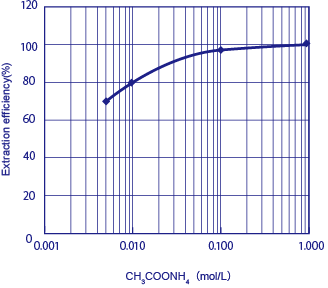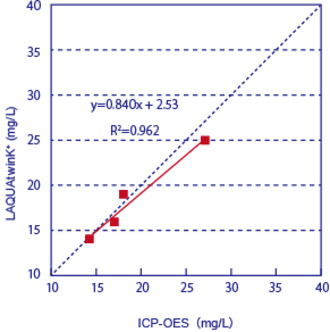Measurement of potassium in various soils with LAQUAtwin
Generally, Atomic Absorption Instrument (AA) or Inductivity Coupled Plasma-Optical Emission Spectrometry Instrument (ICP-OES) is used to measure potassium ion, first by extracting the potassium ion from sample soils by 1 mol/L ammonium acetate CH3COONH4. These are the methods performed in laboratories.
We have developed a method for a rapid measurement of potassium ion in various soils by the use of small and affordable instrument LAQUAtwin potassium ion meter K-11 (Ion Selective Electrode Method). The extraction method is the same as the lab method, which the high concentration existence of CH3COONH4 will affect the measurement result as the ammonium ion in the extraction solution is an interferring ion for the potassium measurement. The following procedure explains how this effect can be reduced to obtain a correlative result as the lab method.
【Measurement procedure】
- Put 1g each of air-dried soils (four samples) in 100mL glass beakers, two beakers per soil sample.
- Prepare two kinds of extraction per soil sample, one by adding 20 ml of 1mol/L CH3COONH4 to one beaker, and 20ml of 0.01mol/L CH3COONH4 to another beaker.
- Shake the beakers around 1 hour to extract K+ from the soil by the use of Petit Bath Shaker Model 2220 made by Wakenyaku Company of Japan.
- Calibrate LAQUAtwin K-11 with 150mg/L and 2000mg/L K+ standard solutions included in the product.
- Measure potassium ion concentration of the filtrated solution with calibrated K-11 and with ICP-OES (HORIBA Jobin Yvon. Model ULTIMA2).
- Perform this measurement with 4 different samples.
*Although the measurement range of K-11 is between 40 mg/L to 4000 mg/L K+, K-11 can perform theoretically down to 4mg/L K+.
【Results】
Table 1 shows the results from ICP-OES and LAQUAtwin K+ extracted with 1 mol/L and 0.01 mol/L CH3COONH4.
Figure 1 shows the potassium extraction efficiency measured with ICP-OES. Setting 1 mol/L CH3COONH4 extraction as 100%, efficiency trend is plotted depending on different CH3COONH4 concentration.
Figure 2 shows the correlation between ICP-OES and LAQUAtwin K+measurements with 0.01 mol/L CH3COONH4 extraction.
Based on table 1, higher value against ICP-OES is detected by LAQUAtwin K+ with 1 mol/L CH3COONH4 extraction, due to strong interference by NH+ of CH3COONH4. However, with 0.01 mol/L CH3COONH4 extraction, although the extraction efficiency is reduced by approximately 80%* (Figure 1), very good correlation (R=0.981,R2=0.962) is obtained between ICP-OES and LAQUAtwin (Figure 2).
*Extraction efficiencies will vary amongst soil samples.
Table1:K+ concentrations measured by ICP-OES and LAQUAtwin extracted with 1 mol/L CH3COONH4 and 0.01 mol/L CH3COONH4.
(Unit : mg/L)

Fig.1:Variation of extraction efficiency with CH3COONH4 concentration.
*Extraction efficiencies will vary amongst soil samples.

Fig.2 Relation between measured values of K+ (mol/L) by ICP-OES and by LAQUAtwin.

Next Page Measurement of calcium in various soils with LAQUAtwin